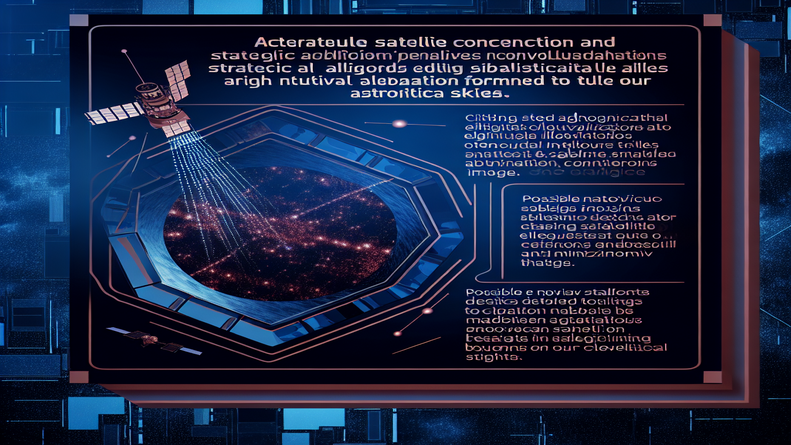As we usher into an era of unprecedented space exploration and satellite deployment, the pristine canvas of our night sky is being cluttered by a multitude of celestial intruders. With every passing year, numerous satellites encroach upon orbits, turning them into a high-speed chase of metal and machinery. This cosmic congestion not only raises concerns over physical space traffic but also casts a shadow over the future of astronomy. Yet, amidst these swirling orbits, scientists echo a resilient determination to safeguard our stellar gateway to the universe’s wonders. In this article, we chronicle the escalating satellite dilemma and the relentless efforts to reclaim the night sky.
Navigating the Orbit Odyssey: The Surging Satellite Population
With advancements in technology and the push for global connectivity, we’ve seen a deluge of satellites enter Earth’s orbits. The promise of high-speed internet, precise global positioning, and comprehensive satellite imagery, although beneficial, brings a bittersweet aftertaste as the stargazers’ vista becomes increasingly star-spangled with the gleam of artificial objects. This section delves into the skyrocketing growth of satellite deployments, examining how the promise of industry and advancement carries the price of our cosmic perspective. Expanding further, Earth’s orbits are not only a strategic asset but also a limited resource. As companies vie for prime orbital slots to maximize their network’s efficiency and coverage, questions arise about equitable access to space and the long-term sustainability of such practices. Here, we venture into the policy-making that’s striving to steer the satellite surge towards a trajectory mindful of shared celestial space.
The Astronomical Dilemma: A Closer Look at the Impacts on Telescopic Triumphs
The stars and planets have whispered secrets of the cosmos to us through the lenses of telescopes for centuries. However, the growing veil of artificial satellites threatens to mute their ancient song. In this segment, we study the practical ramifications of the burgeoning satellite numbers on telescopic research. From interrupted observations due to satellite streaks ruining long-exposure images to the challenges in radio astronomy with increasing background noise, the scientific community’s hardship in maintaining a clear eye on the universe is scrutinized. While ingenuity in science has always navigated past obstructions, the satellite scenario presents a hurdle of a higher orbit. Astronomers and space scientists worldwide are churned between the excitement of new space ventures and the necessity to preserve their window to the wonders beyond. We highlight the initiatives proposing operational adjustments, such as ‘darkening’ satellites or creating exclusion zones in the sky, reflecting their unwavering resolve to not let go of the night sky without a fight.
Illuminating the Dark: Technological Innovations and Strategic Alliances
 In the heart of conflict lies opportunity, and the satellite challenge is no different. This section spotlights the technological innovations and strategic alliances forming as a response to the orbital onslaught. From cutting-edge algorithms capable of editing out satellite trails from astronomical images to satellite designs that minimize reflection, the imaginative solutions aim to disarm the problem rather than concede defeat. Moreover, the active dialogue within the space community, including satellite operators, regulators, and astronomers, suggests a symbiotic alliance in the making. Collectively, they explore the potential for synchronized satellite movements, shared data for better tracking, and even novel orbit paths that alleviate the burdens on our celestial sights. The alliance aims to curate a space environment where progress and preservation co-exist, reflecting a universal respect for our night skies.
In the heart of conflict lies opportunity, and the satellite challenge is no different. This section spotlights the technological innovations and strategic alliances forming as a response to the orbital onslaught. From cutting-edge algorithms capable of editing out satellite trails from astronomical images to satellite designs that minimize reflection, the imaginative solutions aim to disarm the problem rather than concede defeat. Moreover, the active dialogue within the space community, including satellite operators, regulators, and astronomers, suggests a symbiotic alliance in the making. Collectively, they explore the potential for synchronized satellite movements, shared data for better tracking, and even novel orbit paths that alleviate the burdens on our celestial sights. The alliance aims to curate a space environment where progress and preservation co-exist, reflecting a universal respect for our night skies.
From Conflict to Concourse: The Diplomacy of Sharing the Skies
Satellites and stars may seem like apples and asteroids, but in our finite space above, they are forced neighbors that must learn to share the cosmic commons. This narrative embarks on the journey from conflicting interests to concerted concourse, where global policies and space diplomacy play a pivotal role in the preservation of our astronomical heritage. Through international bodies like the United Nations Committee on the Peaceful Uses of Outer Space (COPUOS), we’re witnessing the birth of guidelines and regulations designed to balance the benefits of satellite constellations with the imperative to protect our night skies. Here, we examine the ongoing discussions and draft proposals that aim to build a framework for cooperation, ensuring that the wonders of space remain accessible for future generations of astronomers.
The Satellite Saga: A Chronicle of Resilience and Adaptation
As we wade through the crowded orbits, we’re recounting the saga of satellite deployment – a tale woven with threads of resilience and adaptability. From initial optimistic launches to the current milieu of crowded skies, we’ve witnessed a space sector that’s both vibrant and vigilant. This chapter of our story recognizes the dynamism of the satellite industry, even as it grapples with the unintended celestial clutter it creates. Considering the relentless pace of technology, there’s a relentless spirit in the sector to find a harmony between innovation and introspection. We discover the multifaceted approach that blends sky laws with sky lore, acknowledging both our ambition to reach the stars and our reverence for their timeless glow in the night sky.
Reclaiming the Cosmos: Empowering the Next Generation
The path to preserving our galactic panorama isn’t just about today’s technologies or treaties—it’s also about empowering the next generation of space stewards. This section explores the movements aiming to inspire and educate young minds on the importance of celestial preservation and thoughtful satellite deployment. Through STEM programs, community outreach, and a reinvigorated interest in space ethics, we’re planting the seeds for a future where night skies are as cherished as the satellites that traverse them. We look ahead with hope at a generation rising with the cognizance of their role as both beneficiaries and guardians of our universe’s splendor.Are you captivated by the intricate dance of tech, space, and environmental harmony? Is the vision of a preserved night sky one you wish to contribute to and advocate for? I invite you to join me in this compelling discourse. Connect with me on [LinkedIn](https://www.linkedin.com/in/laurentrochetta/) to delve into the fascinating intersection of celestial stewardship and the frontiers of innovation. 🚀💫 Let’s navigate this starlit journey together.
